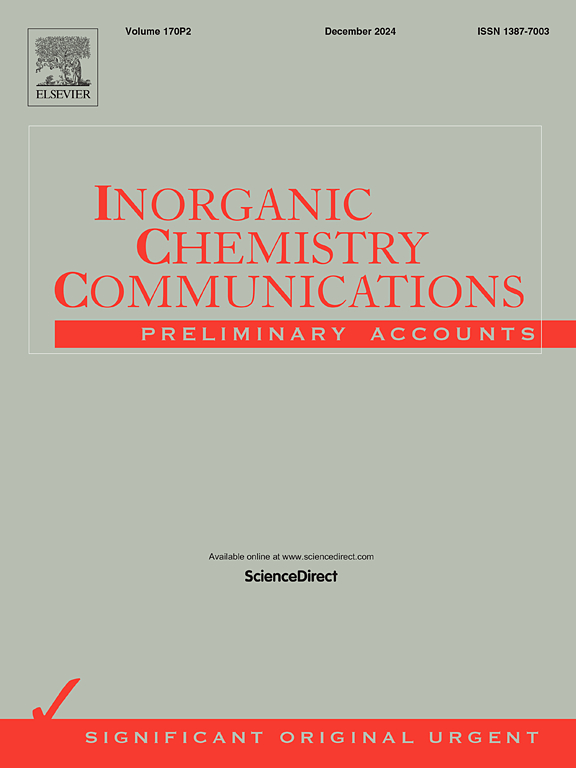银掺杂氧化锌/银异质结构的抗菌潜力增强
IF 4.4
3区 化学
Q1 CHEMISTRY, INORGANIC & NUCLEAR
引用次数: 0
摘要
掺杂和异质结是提高氧化锌抗菌活性的关键技术。在本研究中,采用简单的溶胶-凝胶法和燃烧法将银作为掺杂剂掺入ZnO晶格中。此外,银与ZnO晶体之间还形成了高于银溶解度的意图接触。通过低角XRD谱图峰移和独立附加银峰的出现,成功地证实了掺杂和异质结的存在。HRTEM图像d-spacing分析结果分别为0.26和0.23 nm,证实形成了独立的ZnO和Ag晶体。因此,成功地合成了Ag掺杂ZnO/Ag异质结构(SDSH)。SDSH的平均晶粒尺寸(XRD)约为18 nm,粒径(TEM)在20 ~ 50 nm之间。此外,通过能谱元素映射分析,证实ZnO表面的银掺杂成分纯净,银掺杂分布良好。紫外-可见DRS和PL分光光度计分析结果证实了光学性能的改善和电荷转移的存在。ZnO NPs和SDSH的间接带隙值分别为3.09和2.82 eV。与ZnO NPs相比,SDSH的PL谱强度要低得多,证实了电子-空穴复合位阻的存在。与单一ZnO NPs相比,SDSH也显示出更好的抗菌潜力。SDSH的主要抑菌失活机制被认为是由于NPs和细菌细胞相互作用过程中银和锌离子的释放。本文章由计算机程序翻译,如有差异,请以英文原文为准。

Enhanced antibacterial potential of silver-doped zinc oxide/silver heterostructures
Doping and heterojunction are crucial techniques used to improve the ZnO antimicrobial activity. In this study, silver was incorporated into the ZnO lattice as a dopant using a simple sol–gel followed by a combustion approach. Besides, an intent contact was also formed between silver and ZnO crystals above the solubility level of silver. The doping and heterojunction have been successfully confirmed from the low-angle XRD pattern peak shift and occurrence of independent additional silver peaks, respectively. The HRTEM image d-spacing analysis results of 0.26 and 0.23 nm were also approved for the formation of independent ZnO and Ag crystals, respectively. Thus, Ag-doped ZnO/Ag heterostructure (SDSH) was successfully synthesized. The average crystallite size (XRD) of the SDSH is about 18 nm, and the particle size (TEM) ranges from 20 to 50 nm. Besides, the pure composition and good silver dopant distribution on the surface of ZnO were confirmed from the EDS elemental mapping analysis. The optical property improvement and presence of charge transfer were confirmed from the UV–vis DRS and PL spectrophotometer analysis results. The indirect bandgap values were found to be 3.09 and 2.82 eV for ZnO NPs and SDSH, respectively. The PL spectrum intensity of SDSH is much lower compared to the ZnO NPs, confirming the presence of electron-hole recombination hindrance. The SDSH also showed much better antibacterial potential compared to single ZnO NPs. The major antibacterial deactivation mechanism of SDSH is proposed to be due to the release of silver and zinc ions during NPs and bacterial cell interaction.
求助全文
通过发布文献求助,成功后即可免费获取论文全文。
去求助
来源期刊

Inorganic Chemistry Communications
化学-无机化学与核化学
CiteScore
5.50
自引率
7.90%
发文量
1013
审稿时长
53 days
期刊介绍:
Launched in January 1998, Inorganic Chemistry Communications is an international journal dedicated to the rapid publication of short communications in the major areas of inorganic, organometallic and supramolecular chemistry. Topics include synthetic and reaction chemistry, kinetics and mechanisms of reactions, bioinorganic chemistry, photochemistry and the use of metal and organometallic compounds in stoichiometric and catalytic synthesis or organic compounds.
 求助内容:
求助内容: 应助结果提醒方式:
应助结果提醒方式:


